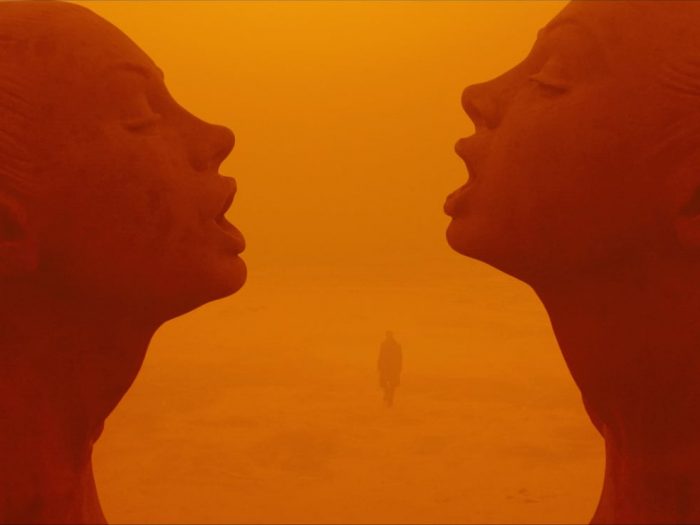Blade Runner (1982) serves as one of the pillars of a dystopian future and science fiction cinema that was popular in the 1980s. Now in the 2010s, the 80s have made a resurgent comeback in the form of remakes like the Terminator and Transformers franchises and reimaginings like Netflix’s Stranger Things. Blade Runner joins these other 80s classics in this cultural trend with its sequel Blade Runner 2049 (2017). Unfortunately, 2049 both surpasses and falls short of its own expectations. In this review, I will not be mentioning the original film when possible. I personally don’t believe that a film should be constantly compared to its sequels or predecessors as I feel this blinds myself to biases. Additionally, the original film has several different edits and it is difficult to pick the “right” cut. And, finally, while the original Blade Runner contains plot points that do tie into the sequel, you can still watch Blade Runner 2049 without watching the original and understand the plot.
But if I had to talk about the original, my main note would be that the sequel’s pacing is far more digestible. Scenes in 2049 seem to happen along a narrative thread that has been weaved into the film. An action happens and there is a clear sequence of events from beginning to end. An example of this are the scenes where K (played by Ryan Gosling) discovers where the replicant child was born, how he gets there, and his subsequent reaction upon reaching there. This narrative thread isn’t necessarily bad, nor does 2049 lack interesting themes, they are just less explored than the 1982 film. 2049 seems to sacrifice the 1982 film’s themes on existence, purpose, and what it means to be human. The original film has truly amazing scenes like Rutger Hauer’s “tears in the rain” monologue and feels much more thought out from a philosophical standpoint. Comparatively, the original is much less linear and narratively driven than 2049, making it harder to follow. This makes 2049 less daunting to watch and gives it a more “adventurey” type of feeling.
But, regarding 2049, Roger Deakins’s masterful cinematography deservedly won an Oscar for his work on the film. His cinematography conveys narrative points, the themes, and the setting’s overall bleakness. One example is how Deakins uses establishing shots to convey the mood of each scene. In the abandoned Las Vegas, we see empty streets covered in sand and dust, where we meet the loner Deckard (played by Harrison Ford). In scenes of Los Angeles, Deakins shows us a city filled with depravity and poverty, where K meets questionable figures. And even outside Los Angeles, we see a giant wall keeping the rising sea levels at bay, where K and Luv (played by Sylvia Hoek) battle over Deckard’s future. Every scene is set up through narrative establishing shots that also inform the viewer thematically. Additionally, this is all done almost entirely without dialogue. Deakins doesn’t accomplish this achievement on his own, the art and set direction should be praised. But in the end, it is Deakins’s cinematography that shows the themes of 2049 in creative and imaginative ways. He blends his shots with CGI, art direction, and set design in a spectacular manner.
Unfortunately, the acting is overall fairly bland. I don’t feel Ryan Gosling’s performance is particularly interesting. For most of the film, K is essentially unresponsive and passive. He drifts through the story, moving at the behest of others and seems reactive rather than proactive. That is until the film’s climax. I can see this passiveness as being part of his narrative arc, in that he gains a sense of agency due to his holographic wife Joi’s (played by Ana de Armas) death. But I don’t think Gosling pulls off the acting required for this arc. The other actors, Harrison Ford, Robin Wright, and Jared Leto, are all fine. The issue is that their characters are not developed very much. Regarding the acting, the most memorable scene is the film’s ending. In one of the most emotional scenes in the film, Deckard reacts to seeing his daughter for the first time. Unfortunately, this is one of the very few scenes that moved me. The unresponsiveness and passiveness of K, our main character, left me wanting more. Perhaps a symptom of the acting, the highs and lows of the film don’t feel as high as they should.
My final thoughts on Blade Runner 2049 are that it is not the same groundbreaking film that the original was. Instead, it is a very visually and audibly beautiful film with a fairly good plot. The cinematography alone merits a viewing. Deakins’s work should set a precedent for any filmmaker looking to make a science fiction film. Additionally, the soundtrack fits the film wonderfully. It creates a sense of wonder and dread, a truly grimdark feeling while audibly true to the original. Unfortunately, the film is held back by bland acting, which weighs down its narrative highs and lows. K’s emotional turmoil isn’t shown until the end, which made it difficult for me to fully enjoy engross myself with K’s arc. While the film has issues, it still merits viewing and can be appreciated for its risks in a blockbuster-dominated industry.
Author Biography
Benjamin Bergstrom is a freelance editor, writer, and director working in the Greater New York City area. He attended Ithaca College and graduated in 2018. Ben has worked on multiple types of projects, including documentaries, narratives, and news media. He is currently working on the reality television show North Woods Law as a freelance assistant editor at Engel Entertainment.
Film Details
Blade Runner 2049 (2017)
USA/UK/Hungary/Canada/Spain
Director Denis Villeneuve
Runtime 163 minutes









































